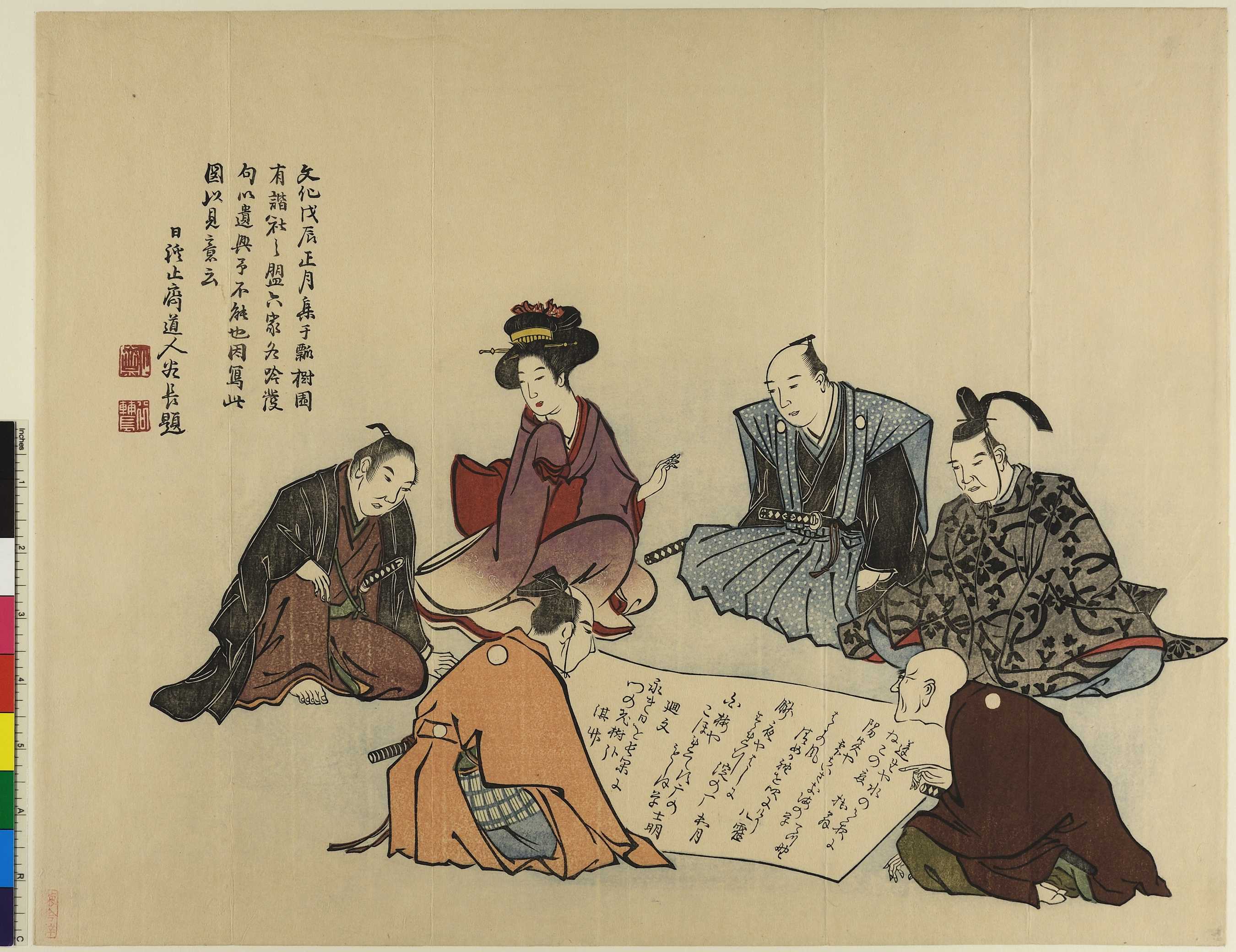-
Scott JOHNSON (Kansai University, Osaka, emeritus) スコット・ジョンソン(関西大学名誉教授)
This presentation will begin with a brief description of a typical large haikai surimono, in this case including a poem by Kishō, illustrated by an Osaka artist, and compiled by a prominent Osaka professional. Then, I will introduce the 1820 Osaka cultural world that Kishō dreamed of, using many "close-up" illustrations by Tamate Tōshū (1795-1871) and a couple of "long-shot" illustrations by Niwa Tōkei (1760-1822). Then, the focus shifts to the poet himself, with a photograph showing the lower end of Lake Biwa, and the then remote "Mirror Mountain" where Kishō lived at its base. Known locally as Tamao Tōsaburō, he was a rice farmer, but also a merchant of a fish-based fertilizer.
FIRST STOP: Kishō's haiku journey to Osaka began with his contacting the priest Sen'ei (1756-1825) at Miidera temple in Ōtsu. Sen'ei talked and corresponded with amateur haiku poets, but he did not publish anything himself. He was a contributor to a new haiku annual published in Osaka by Oka Seibi (1760-1837). Sen'ei may also have known about a wealthy Kyoto amateur who published surimono.
NEXT STOP: Kyoto, where I will introduce Kitagawa Baika (1773-1843), a priest at a major temple in Kyoto, and a dedicated amateur haiku poet. Baika was wealthy enough that he could compile and publish haikai surimono, such as "descending haiku", a surimono with a poem by Kishō.
FINAL STOP: Osaka, where I will show professional compiler Oka Seibi, and his haiku poetry anthology Kachō Bunko (Flower-and-bid Library), with 1818 and 1819 issues containing poems by Kishō, but also by the most famous haiku poet alive in 1820: Kobayashi Issa (1763-1828).
With Kishō on his mailing list, Oka Seibi sent woodblock New Year greetings every year, as well as occasional letters. And, as the dreams of Kishō and Seibi converged, Kishō received an announcement of deadlines for poetry, and fees for appearances in small surimono (for which you will get ten impressions), or in a large surimono (for which you will get five impressions). Looking again at the big surimono, we can now do the math: 48 poets times five leads to a print run of 240 impressions.
Now we can see poet Kishō in a new light. Living deep in the woods of Ōmi, he treasured every bit of
correspondence, and became a historian's dream: he kept everything.
The Tamao family archives are stored in the National Institute of Japanese Literature in a suburb of Tokyo. In 1996, Katō Sadahiko transcribed many letters and documents, including the surimono business details. This was the first clear documentation of money fees and print runs for any woodblock print in the Edo period.
本発表ではまず、大坂の職業俳人を編者とし、大坂の絵師が絵を手がけ、寄松という俳人の句を含む、典型的な大奉書判俳諧摺物についての説明を手短にしたい。次に、寄松が夢見た 1820年(元号で言えば文政3年)の大坂の文化世界を紹介したい。そのために玉手棠洲(1795-1871)の生き生きとした「近接」描写と、丹羽桃渓(1760-1822)の「鳥瞰的」な描写による作品を参照する。そして、俳人・寄松本人に焦点を移し、琵琶湖の湖南地域の写真を示して、寄松が住んでいた鏡山(当時は遠く離れたところと受け止められていた)に思いを馳せたい。寄松は地元では玉尾藤三郎として知られ、米栽培の農家が生業であったが、干鰯(肥料)の販売もこなした。
第一逗留点、大津。寄松の大坂への俳諧の旅は、大津三井寺の僧・千影に接触したことから始まる。千影は素人俳人たちとの交流はあったが、彼自身が俳諧出版物を出すことはなかった。千影は職業俳人・岡井眉によって大坂で出版された歳旦帖に句を寄せている。千影はまた、摺物を自費出版するような京都の富裕な素人俳人と知り合いであった可能性もある。
第二逗留点、京都。北川(喜多川)梅價は京都の大寺の僧であり、熱心な素人俳人であった。梅價には俳諧摺物の編纂出版するだけの財力があり、例えば、寄松の句が載る「落雁」摺物は梅價の手になる。
目的地、大坂。職業俳人・岡井眉とその編になる俳書『華鳥文庫』を見てみたい。『華鳥文庫』文政元年(1818)および同二年(1819)版には、寄松の句だけでなく、1820 年時点で最も有名な俳人・小林一茶の句も含まれている。
寄松は岡井眉と文通があり、毎年新年を寿ぐ木版摺の賀状や、時には手紙も受け取っていた。そして、寄松と井眉それぞれの想いが重なったところで、寄松は俳諧摺物への寄稿の締め切り日と手数料(小型判型の摺物なら 10 枚もらえる、大型の摺物なら 5 枚もらえる)の知らせをを受け取ることとなった。例えば先の摺物を例にすれば、48 人の俳人が句を寄せた大奉書判摺物の場合、48 人が 5 枚の摺物で、総計 240 枚が摺られたことになる。
今日われわれは、俳人・寄松を新たな日のもとで見ることができる。近江の森奥深く住んでいた寄松は、俳人とのやりとりの一つ一つを大切にとっていたのである。すべてをとっていたため、歴史家にとって寄松は夢のような存在である。
玉尾家の文書は、東京の郊外にある国文学研究資料館に保管されている。1996 年、加藤定彦氏が多くの書簡や文書を翻刻し、摺物出版に関する詳細も知られるところとなった。これが、江戸時代の木版一枚摺に関する料金や印刷枚数についての最初の明確な記録と言える。
動画 (要パスワード)
-
関連記事
Notes on "A Haiku Journey to Osaka" 大坂行き俳諧旅についての一考察

